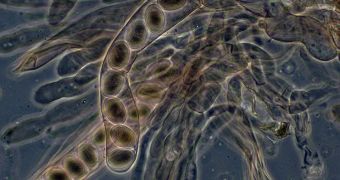About 251.4 million years ago, nearly all lifeforms on the planet died, during the largest mass extinction event ever to take place on Earth. Researchers are now saying that fungi played an important role in destroying the forests that were left unscathed by the original catastrophes.
The Permian–Triassic (P–T) extinction event is colloquially referred to as The Great Dying. An estimated 70 percent of all land-based vertebrates were killed, as were more than 96 percent of all marine species. Some 83 percent of all genera and 57 percent of all families disappeared as well.
None of the other five global extinction events researchers is known to have brought Earth so close of losing all its lifeforms. Despite its severity, experts still debate what caused the P-T event, with many saying it occurred gradually, while others argue that the extinction took place in stages.
Regardless of how things went down, a team of researchers proposes in a new study that fungi had an important part to play in destroying the world's forest. At the time, a special breed of aggressive, tree-killing fungi developed, that wiped out forests over widespread areas.
This undoubtedly contributed to worldwide climate change, as vast amounts of dangerous greenhouse gas carbon dioxide (CO2) were released into the atmosphere. The international collaboration that conducted the study was led by experts at the University of California in Berkeley (UCB).
The reason why studies such as this are important is because global warming today is favoring the development of highly-infectious soil bacteria. The microorganisms have the capability to devastate forests, especially know that the trees are already under a lot of pressure from warming and pollution.
Details about the new investigation were published in the August 5 online issue of the Geological Society of America's (GSA) journal Geology. The study will also appear in the September print issue of the magazine.
At the time of the P-T event, most of the world's forests were made of conifers, ancestors of modern pines and firs. Immense volcanic eruptions in what is now Siberia are believed to have caused the extinction, although other factors may have been involved as well.
The ancestors of the modern tree-killing fungus Rhizoctonia are commonly found in Permian rock as filamentous microfossils. Experts say that they were most likely responsible for the swift and decisive decline of forests during the extinction event.
“Modern Rhizoctonia include some of the most ubiquitous plant pathogens, causing root, stem and foliar diseases in a wide variety of plants,” UCB assistant professor of integrative biology Cindy Looy explains. She is also a coauthor of the new study.
“Based on patterns of present-day forest decline, it is likely that fungal disease has been an essential accessory in woodland destabilization, accelerating widespread tree mortality during the end-Permian crisis,” she concludes.

 14 DAY TRIAL //
14 DAY TRIAL //